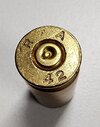CQB45ACP
Member
I’ve linked to a great article on testing case longevity for 45acp. For all I know it was written by one of you.
Some key takeaways—
Using new Starline cases measuring .894”, after 20 firings they measured SAAMI minimum .888”.
Cases shortened after each firing and at the head, not mouth.
While cases got shorter with each firing, after 54 they were never short enough to headspace off the extractor.
Case mouth did not get thicker after firings.
After 30 firings, primer pocket had become shallower to the point primer wouldn’t fully seat and kept getting shallower.
Test ended after 54 firings not because of splitting or other failure but because primer could not be safely seated.
Hope you find this as interesting as did I.
 www.floridareloading.com
www.floridareloading.com
Some key takeaways—
Using new Starline cases measuring .894”, after 20 firings they measured SAAMI minimum .888”.
Cases shortened after each firing and at the head, not mouth.
While cases got shorter with each firing, after 54 they were never short enough to headspace off the extractor.
Case mouth did not get thicker after firings.
After 30 firings, primer pocket had become shallower to the point primer wouldn’t fully seat and kept getting shallower.
Test ended after 54 firings not because of splitting or other failure but because primer could not be safely seated.
Hope you find this as interesting as did I.


